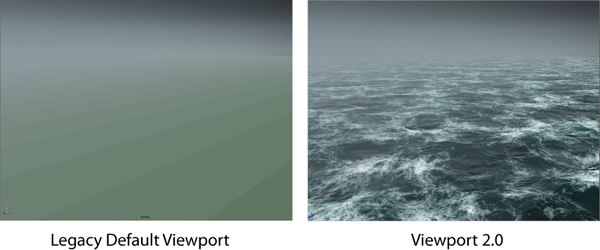
Viewport 2.0 supports all common workflows in Maya. In addition, Viewport 2.0 provides features that are not available with the Legacy Default Viewport; for example, viewport effects such as ambient occlusion and anti-aliasing. Fidelity of lighting and materials is also much improved in Viewport 2.0. Furthermore, it provides much better performance for polygons and tessellation, and improves scene performance through the use of features such as vertex animation cache and GPU instancing.
In this scene, an Ocean Shader is applied to a plane. The difference between working in the Legacy Default Viewport and in Viewport 2.0 is demonstrated below.

Select
Renderer > Viewport 2.0 >
![]() to open the
Hardware Renderer 2.0 Settings window. See
Viewport 2.0 options for more information.
to open the
Hardware Renderer 2.0 Settings window. See
Viewport 2.0 options for more information.
Performance improvements
Viewport 2.0 also includes the following performance improvements over the legacy default viewport:
- GPU Instancing enabled by default so that if you have multiple instances (or especially a large number of instances) of a Maya shape, and all of which use the same material, then they render using hardware instancing for much faster rendering results. See
GPU Instancing for more information.
- GPU Cache benefits from GPU Instancing
-
Significant performance improvement in Viewport 2.0 for scenes with huge amounts of geometry or cached animation that does not fit in GPU memory.
In most cases, your scene should run interactively in Maya if these conditions are met:- The entire scene in Maya does not exceed the system RAM,
- The visible portion of the scene in the viewport may modestly exceed the GPU RAM.
When writing your own plug-in, you can also use the MPxSubSceneOverride class to take advantage of this performance improvement.
See the Maya Developer Help for more information.
In addition, any plug-in that implements a custom shape as a user defined shape node (MPxSurfaceShape), without the use of any Viewport 2.0 API classes, can also benefit from performance improvement.
- particle geo instancer support that makes use of GPU instancing to provide performance improvement over the default viewport
- Limitation: motion blur and screen space ambient occlusion are not supported for the particle geo instancer
-
 MultiDraw Consolidation is active by default in OpenGL mode in Viewport 2. It increases viewport performance by combining traditional consolidation for static objects and MultiDraw consolidation for non-deforming animated objects (including meshes, NURBS surfaces, NURBS curves, and other geometry) when drawing in the viewport. For more information see
General variables. MultiDraw provides performance gains particularly in scenes that have large numbers of non-deforming objects. Non-animated scenes are unaffected.
MultiDraw Consolidation is active by default in OpenGL mode in Viewport 2. It increases viewport performance by combining traditional consolidation for static objects and MultiDraw consolidation for non-deforming animated objects (including meshes, NURBS surfaces, NURBS curves, and other geometry) when drawing in the viewport. For more information see
General variables. MultiDraw provides performance gains particularly in scenes that have large numbers of non-deforming objects. Non-animated scenes are unaffected.
- Limitation: Due to missing graphics stack support on Mac OS X, MultiDraw Consolidation is not available.